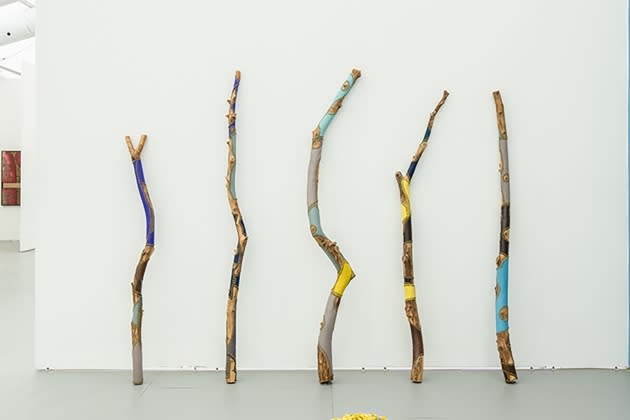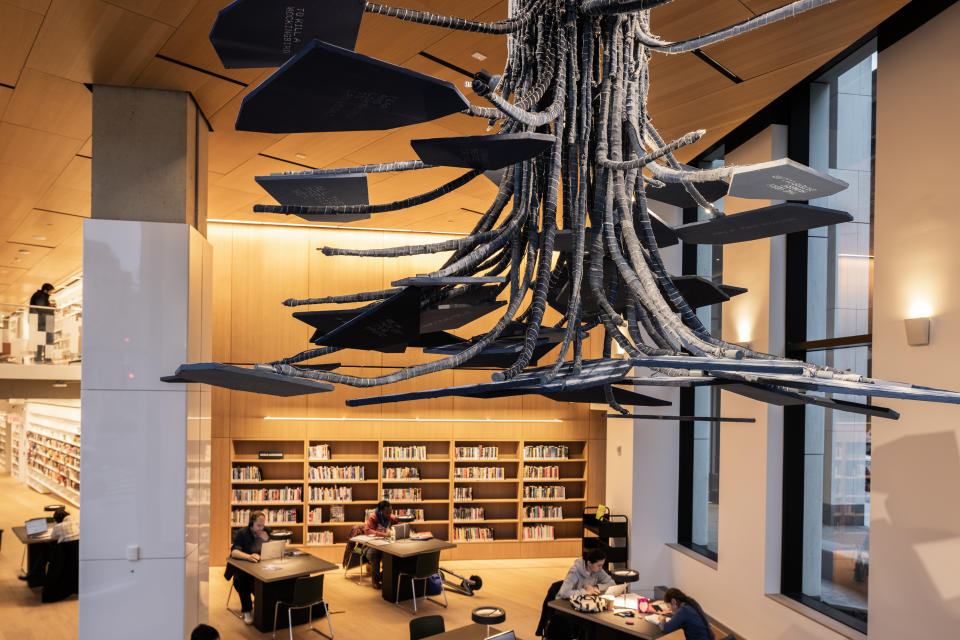Jean Shin’s Art Just Keeps Evolving
- Oops!Something went wrong.Please try again later.

“I feel responsible for these things,” Jean Shin says during a tour of her studio, a converted three-story barn on the outskirts of Kingston, New York, that is filled nearly to the rafters with discarded items — brightly colored computer cables neatly coiled like snakes, fraying blue denim sliced into long narrow strips, and stacks of matchbook-sized museum photography slides, still bearing the careful handwriting of archivists and art history professors.
Shin’s work honors these and other cast-off items, assembling what some would call waste into elaborate narrative sculptures that often explore the lasting social and environmental impacts of American consumer culture.
More from WWD
Swatch x Jean-Michel Basquiat Collection Reimagines Iconic Motifs
A Look Inside Alessandro Maria Ferreri's Gorgeous Rome Apartment
Inside Avant-garde Fashion Photographer 'Gus' Peterson Spotlighted in New Exhibition
Naturally, Shin recycles even her own work.
A gallery show opening June 16 at Praise Shadows in the Boston area repurposes elements from two recent public art projects to create indoor sculptures on a much more intimate scale.
“Jean is so prolific,” says Yng-Ru Chen, her current gallerist and the founder of Praise Shadows. “Once these huge installations for museums and outdoor spaces get dismantled, they’re packed into crates and stored in her studio where space is finite. No one sees them. One of her goals when we began working together was to extend the life of these important works.”
For “Second Skin,” Shin reworked components of “Freshwater,” a complex living piece commissioned by the Philadelphia Contemporary last year that flowed polluted water from the Delaware River through a series of cascading glass orbs. Each hand blown glass vessel contained at least one live freshwater mussel. The mollusks strained impurities out of the water, spilling clean liquid into pools lined with thousands of shimmering mother-of-pearl buttons.
“I really felt like I needed to highlight issues of extinction,” Shin says of the project, which was inspired by the boom-and-bust cycle of U.S. mother-of-pearl button manufacturing in the 1800s and 1900s. Many species of American river mollusks were overharvested, right as the introduction of dams further strained their populations.

Whole colonies collapsed. Some species vanished entirely.
Then the switch to plastics collapsed the pearl button market, leaving millions of these delicate fasteners boxed up in warehouses, unappreciated, gathering dust.
Meanwhile, rivers stripped of the natural filters that once extracted bacteria, algae and pollutants from their beds saw their water quality decline for several decades.
“A lot of my works start as an experiment in the studio, and then they get transformed into what the site needs,” Shin says. To build “Freshwater,” she had to enlist the help of manufacturers to donate deadstock buttons as well as scientists breeding new genetically engineered mussels to help restore balance to these fragile ecosystems.
“Her installations are very labor-intensive,” says Eva Respini, the former chief curator of the Institute of Contemporary Art Boston, who gave Shin her first major exhibition, at MoMA QNS in Queens, New York, back in 2004. “She is incredibly collaborative and collegial and kind. That sense of generosity enables her to recruit all sorts of people to donate items for her work.”
In Shin’s upcoming gallery show, one of the glass orbs from “Freshwater” sits atop a small pedestal, overflowing with iridescent buttons — like a mouth, glutted.
The other project Shin mined for “Second Skin” is “Fallen,” a piece she originally installed in the spring of 2021 at Olana, the former home of Hudson Valley painter Frederic Church, now a New York State historic site. A giant 140-year-old Eastern hemlock had died on the property, and as a sign of respect, Shin wrapped its trunk in a patchwork leather shroud, then laid it to rest on the grounds.
For that project, Shin researched the history of hemlocks in the Northeast and discovered that many of the Catskills’ old growth forests were wiped out in the 1800s as the leather tanning industry exploded across the region. Millions of hemlocks were stripped of their tannin-rich bark to cure leather, leaving the naked trunks to rot.
“Because these trees have so many branches, you get a lot of knots in the wood,” Shin says. “So they were not valuable for lumber. Carpenters did not want them.”
Reading about this staggering loss prompted Shin to pull out a cache of leather cutouts she had stored in her studio since 2016. During a residency at Materials for the Arts, a nonprofit repository for working artists in New York City, Shin unboxed several donations from Marc Jacobs and Chloé.
“I found all of this beautiful brightly colored leather and knew immediately I would use it someday,” Shin says. “I just didn’t know how.”
The supple skins were likely leftover from accessories production, with holes cut into the hides suggesting a bag maybe, or a shoe.
Shin selected skins in colors she knew would complement the Olana landscape — mostly yellows, blues and browns — deeming the deep red, wine and pink hides she left in storage “too violent.” She cut, arranged, and stitched the pieces together herself, adding in a few scraps donated by upholsterers and used brass upholstery tacks to hold the shroud around the tree.
“Fallen” remained on the Olana grounds for six months, exposing the leather to the decaying wood, dirt, sun, wind and rain — all of which left their marks.
“I love how you can still see the memory of the tree,” Shin says of the sun-bleached patterns and stretch marks created by pulling the leather taut over stumps of severed limbs and rough bark. “The story of the hemlock remains.”
At the end of the installation, Shin painstakingly dismantled the shroud and washed and conditioned all of the leather — while dreaming up ways of repurposing it.
“Jean is maybe the first artist ever to spend an entire MacDowell residency cleaning leather,” Chen jokes of Shin’s stay at the artists’ colony in Peterborough, New Hampshire, last winter.
Shin says the process felt a bit like a mourning ritual. “These were all originally calf skins,” she says. “I decided I wanted to bring them back to the body.”
Several sections have been sewn together to create a pair of wall hangings that do indeed resemble intact hides. Those hang from slender hemlock branches salvaged from the original tree.
Other leather pieces have been mounted on wooden boards using the leftover brass tacks, forming what look like three-dimensional paintings, with small branch stumps protruding through deliberate gaps.
The last of the hemlock branches Shin was able to save has also been wrapped in leather, forming leaning sculptures that rest against the wall similar to prototypes Chen sold at United Art in Miami last December. (They all went to major museum trustees and collectors.)
Sarah Arison, who chairs the boards of MoMA P.S.1 and YoungArts, a program Shin benefited from as a teenager and now assists as a mentor, purchased one of the limbs.
“Jean is incredibly beloved and well-respected in the art world,” Arison says. “Not just as an artist but also as a mentor. She has always prioritized being a resource and leader for the next generation, which is rare for someone of her stature.”

Respini, who will bring a Shin installation to the Armory show in Manhattan this fall, finds the artist’s work especially restorative at this particular moment. “There’s a community aspect to her work, in the gathering of the materials, their meaning, how they’re used — and then reused — which is all very unique,” Respini says. “We’ve just lived through the pandemic and a lot of unrest. Building something together via community is a really powerful statement we all need right now.”
Best of WWD

